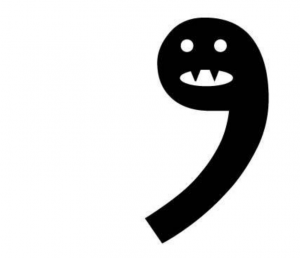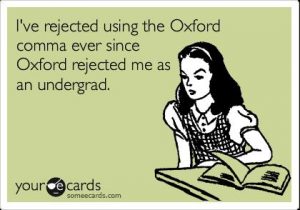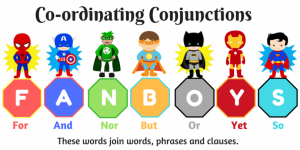A Lesson in Using Commas Like a Boss
Commas are used to indicate pauses, but where I pause and where you pause in a sentence are different, right? No. no. no. Commas have very distinct rules, and if you want to ensure you’re using them correctly, see below. *mic drop*

The Direct Address Comma
Let’s eat Grandma!
Let’s eat, Grandma!
When you are directing someone, it’s polite to use a comma. Otherwise you may find yourself in a…well.. awkward predicament. “Leftover Grandma, anyone?” *gross*
Dialogue
“There you go,” Sally said.
Whenever you use quotes, a comma (or period) belongs between the quote and the dialogue tag. And remember that punctuation always goes INSIDE the quotation mark.
Which / That
“Which” is usually preceded by a comma, “that” usually isn’t.
Lists
Separate items in a list with a comma. The longest item in the list should go last. If you’re separating items that contain commas, like cities and states, separate this list with a semicolon. Ex: Last summer I visited Seattle, Washington; Boulder, Colorado and Austin, Texas.
Oxford / Serial Comma

The Oxford comma is hotly debated between styles. It’s the last comma in a list that uses a conjunction. For example, in “dogs, cats, and rabbits”, the Oxford comma is between “cats” and “and”. Whether you consult your style guide or follow your heart, make sure you are consistent! (AP Style omits the Oxford comma while Chicago Manual of Style includes it.) There is no right or wrong answer here, but inconsistency is not a cute look.
Coordinating Conjunctions
Okay listen up. This is the comma that makes so many lose their comma confidence.
When a coordinating conjunction joins two independent clauses, a comma is used before the coordinating conjunction (unless the two independent clauses are very short). Conjunctions that are not followed by non-essential elements should never be followed by commas.

Quick review: Coordinating conjunctions are the FANBOYS words: for, and, nor, but, or, yet, so.
Ex:
I went to the store and bought some apples.
“bought some apples” is a dependent clause, so no comma is used
Ex:
I went to the store, and I had to buy Pink Ladies!
In this example, both clauses are independent, so a comma is necessary.
Logical Connectors
Logical connectors are used to join or connect two ideas that have a particular relationship. These relationships can be: sequential (time), reason and purpose, adversative (opposition and/or unexpected result), condition. In general (look, I’m using one now), these are preceded and/or followed by a comma depending on where it’s placed in the sentence.
In general, I like ice cream.
I’d say I like ice cream, in general.
I’d say, in general, I like ice cream.
Increase Your Comma Confidence
Whenever you’re lacking confidence, it helps to seek validation from an expert. At AMC, our content team pays critical attention to the details, and we’re committed to getting the basics right 100% of the time.
If you’re debating whether content marketing is a good investment, you might want to check out our whitepaper: When Is Content Marketing Worth the Investment?







